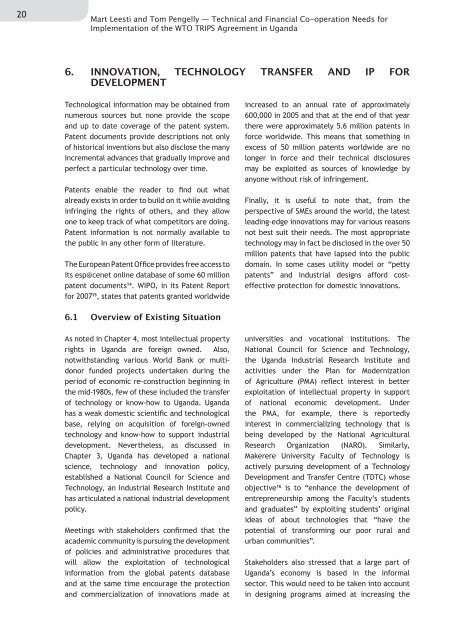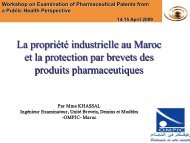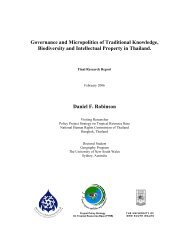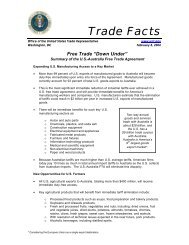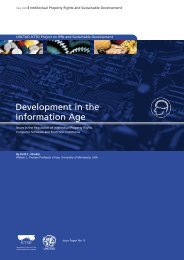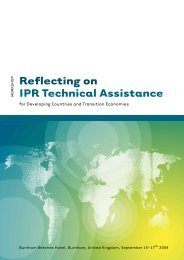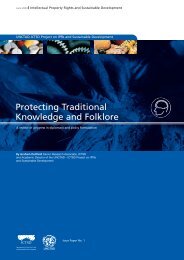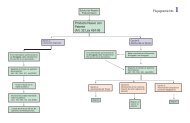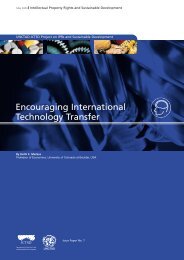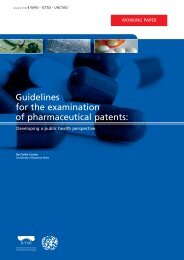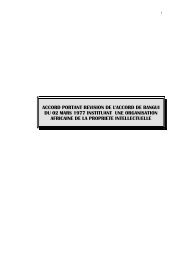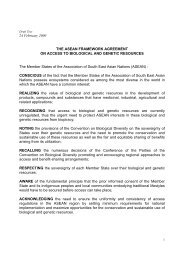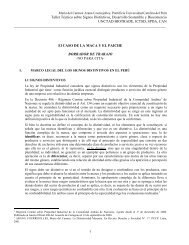Final Report of Uganda Intellectual Property ... - IPRsonline.org
Final Report of Uganda Intellectual Property ... - IPRsonline.org
Final Report of Uganda Intellectual Property ... - IPRsonline.org
Create successful ePaper yourself
Turn your PDF publications into a flip-book with our unique Google optimized e-Paper software.
20<br />
Mart Leesti and Tom Pengelly ― Technical and Financial Co-operation Needs for<br />
Implementation <strong>of</strong> the WTO TRIPS Agreement in <strong>Uganda</strong><br />
6. INNOVATION, TECHNOLOGY TRANSFER AND IP FOR<br />
DEVELOPMENT<br />
Technological information may be obtained from<br />
numerous sources but none provide the scope<br />
and up to date coverage <strong>of</strong> the patent system.<br />
Patent documents provide descriptions not only<br />
<strong>of</strong> historical inventions but also disclose the many<br />
incremental advances that gradually improve and<br />
perfect a particular technology over time.<br />
Patents enable the reader to find out what<br />
already exists in order to build on it while avoiding<br />
infringing the rights <strong>of</strong> others, and they allow<br />
one to keep track <strong>of</strong> what competitors are doing.<br />
Patent information is not normally available to<br />
the public In any other form <strong>of</strong> literature.<br />
The European Patent Office provides free access to<br />
its esp@cenet online database <strong>of</strong> some 60 million<br />
patent documents 14 . WIPO, in its Patent <strong>Report</strong><br />
for 2007 15 , states that patents granted worldwide<br />
increased to an annual rate <strong>of</strong> approximately<br />
600,000 in 2005 and that at the end <strong>of</strong> that year<br />
there were approximately 5.6 million patents in<br />
force worldwide. This means that something in<br />
excess <strong>of</strong> 50 million patents worldwide are no<br />
longer in force and their technical disclosures<br />
may be exploited as sources <strong>of</strong> knowledge by<br />
anyone without risk <strong>of</strong> infringement.<br />
<strong>Final</strong>ly, it is useful to note that, from the<br />
perspective <strong>of</strong> SMEs around the world, the latest<br />
leading-edge innovations may for various reasons<br />
not best suit their needs. The most appropriate<br />
technology may in fact be disclosed in the over 50<br />
million patents that have lapsed into the public<br />
domain. In some cases utility model or “petty<br />
patents” and industrial designs afford costeffective<br />
protection for domestic innovations.<br />
6.1 Overview <strong>of</strong> Existing Situation<br />
As noted in Chapter 4, most intellectual property<br />
rights in <strong>Uganda</strong> are foreign owned. Also,<br />
notwithstanding various World Bank or multidonor<br />
funded projects undertaken during the<br />
period <strong>of</strong> economic re-construction beginning in<br />
the mid-1980s, few <strong>of</strong> these included the transfer<br />
<strong>of</strong> technology or know-how to <strong>Uganda</strong>. <strong>Uganda</strong><br />
has a weak domestic scientific and technological<br />
base, relying on acquisition <strong>of</strong> foreign-owned<br />
technology and know-how to support industrial<br />
development. Nevertheless, as discussed in<br />
Chapter 3, <strong>Uganda</strong> has developed a national<br />
science, technology and innovation policy,<br />
established a National Council for Science and<br />
Technology, an Industrial Research Institute and<br />
has articulated a national industrial development<br />
policy.<br />
Meetings with stakeholders confirmed that the<br />
academic community is pursuing the development<br />
<strong>of</strong> policies and administrative procedures that<br />
will allow the exploitation <strong>of</strong> technological<br />
information from the global patents database<br />
and at the same time encourage the protection<br />
and commercialization <strong>of</strong> innovations made at<br />
universities and vocational institutions. The<br />
National Council for Science and Technology,<br />
the <strong>Uganda</strong> Industrial Research Institute and<br />
activities under the Plan for Modernization<br />
<strong>of</strong> Agriculture (PMA) reflect interest in better<br />
exploitation <strong>of</strong> intellectual property in support<br />
<strong>of</strong> national economic development. Under<br />
the PMA, for example, there is reportedly<br />
interest in commercializing technology that is<br />
being developed by the National Agricultural<br />
Research Organization (NARO). Similarly,<br />
Makerere University Faculty <strong>of</strong> Technology is<br />
actively pursuing development <strong>of</strong> a Technology<br />
Development and Transfer Centre (TDTC) whose<br />
objective 16 is to “enhance the development <strong>of</strong><br />
entrepreneurship among the Faculty’s students<br />
and graduates” by exploiting students’ original<br />
ideas <strong>of</strong> about technologies that “have the<br />
potential <strong>of</strong> transforming our poor rural and<br />
urban communities”.<br />
Stakeholders also stressed that a large part <strong>of</strong><br />
<strong>Uganda</strong>’s economy is based in the informal<br />
sector. This would need to be taken into account<br />
in designing programs aimed at increasing the


